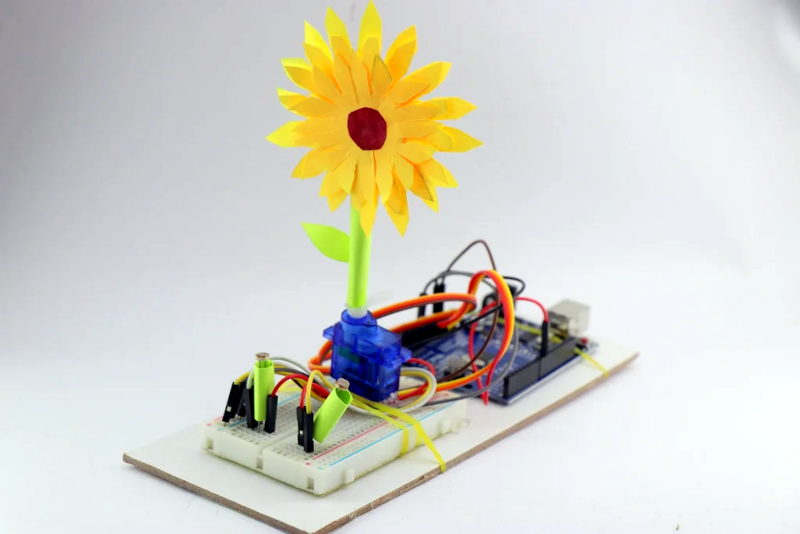Real flowers do it, and even the Beatles did it. [Robo Hub] now has a plastic sunflower that tracks the sun using, of course, an Arduino. It may not qualify as a real robot, but it does mimic a real sunflower. The electronics aren’t earth-shattering, of course. An Arduino, a light sensor, and a servo motor are all you really need. But we enjoyed the whimsy and the artistic sensibility. This would be a great school project, for example. Interesting enough to get kids interested but not so hard as to be undoable. You can see a video of the ersatz flower below.
There are actually a pair of light sensors, as you might expect. That way you can determine which sensor is getting the most light. Obviously, these can’t be on-off sensors. They are, in fact, light-dependent resistors, so you get a nice analog reading.
Of course, you might not need an Arduino for this. A 555 driving a servo and a handful of discrete components could measure a bridge with the photoresistors and get the same effect. On the other hand, a microcontroller these days is inexpensive and versatile, so why not?
Usually, people tracking the sun are trying to get more energy. That doesn’t have to be any more complicated, though.

















Challenge: implement this with 555 timers.
If you arrange the geometry so the LDR is shaded when the sunflower moves to cover it, you can do it with one 555, a single LDR, one resistor and one capacitor. (Plus a couple of decoupling caps.)
Pretty sure you could do this with a few transistors
Replace the RC servo with a DC brushed motor, you can do it with a single LDR, a darlington, and two resistors. And two batteries to form the split supply. Won’t be efficient though.
But an Arduino is more teachable these days.
Google BEAM 555 circuit sun tracker, been there, done that.
sun tracker can be done with basic BEAM circuits.
Fun little project. But it could be done without a microcontroller at all.
[youtube https://www.youtube.com/watch?v=wL9PcGu_xrA?version=3&rel=1&showsearch=0&showinfo=1&iv_load_policy=1&fs=1&hl=en-US&autohide=2&wmode=transparent&w=800&h=480%5D
Sorry, is it just me, or shouldn’t all “proper” solar tracking projects be solar powered?
Suntracker can be done with basic BEAM circuit.
what is a BEAM circuit?
Google is your friend.
ChatGPT is certainly friendlier than you with its response:
“A BEAM circuit refers to a type of robotics technology that stands for “Biology, Electronics, Aesthetics, and Mechanics.” It’s an approach to creating simple and robust robots inspired by biological systems. BEAM robots often use analog circuits and are designed to exhibit lifelike behaviors with minimal electronic components. The emphasis is on efficiency, simplicity, and adaptability. It’s a cool fusion of biology and engineering!”
🤣
I’m sure there’s a Beatles joke here, but Something’s not coming to me.
I think this works too! :-)
https://youtu.be/kHhVRQ3eDP8?si=tMO2iqt7UKvt8xNQ